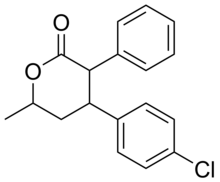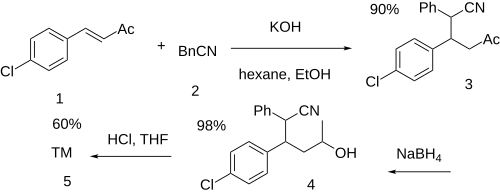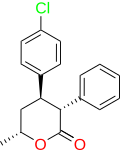Lomevactone
Source: Wikipedia, the free encyclopedia.
Chemical compound
 | |
| Clinical data | |
|---|---|
| ATC code |
|
| Identifiers | |
| |
JSmol) | |
| |
Lomevactone (
psychostimulant and antidepressant which was synthesized and assayed in the 1980s, but was never marketed.[1][2]
Stereoisomers
There are eight possible
stereoisomers of lomevactone. It is the (3R,4R,6R)-form that has the psychotherapeutic properties.[3][4]
Synthesis
The conjugate 1,4-alkylation reaction between 4-chlorobenzylideneacetone (1) and
phenylacetonitrile (2) gives 3-(4-chlorophenyl)-5-oxo-2-phenylhexanenitrile (3). The selective reduction of the keto group to the alcohol with sodium borohydride
gives 3-(4-chlorophenyl)-5-hydroxy-2-phenylhexanenitrile (4). Hydrolysis of the nitrile to an acid gives 3-(4-chlorophenyl)-5-hydroxy-2-phenylhexanoic acid. This is followed by lactone formation completing the synthesis of lomevactone (5).

References
- ISBN 0-412-46630-9.
- S2CID 2372145.
- ^ Axiotis, S.; Druex, J.; Perrin, M.; Royer, J. (1982). "Conformations in the tetrahydropyran-2-one ring". Tetrahedron. 38 (4): 499–504. doi:10.1016/0040-4020(82)80093-8.
- .
- ^ Axiotis, S. et al, Eur. J. Med. Chem.-Chim. Ther., 1981, 16, 431, 439.
- ^ Pierre Simon & Jacques Dreux, U.S. patent 4,287,206 (1981 to Sanofi Aventis France).
- ^ 시몽 삐에르 & 드로 짝끄, KR830002288 (1983).
| ||
|---|---|---|
SNRIs Tooltip Serotonin–norepinephrine reuptake inhibitors | ||
NRIs Tooltip Norepinephrine reuptake inhibitors | ||
NDRIs Tooltip Norepinephrine–dopamine reuptake inhibitors | ||
NaSSAs Tooltip Noradrenergic and specific serotonergic antidepressants | ||
SARIs Tooltip Serotonin antagonist and reuptake inhibitors | ||
SMS Tooltip Serotonin modulator and stimulators | ||
| Others |
| |
TCAs Tooltip Tricyclic antidepressants |
| |
|---|---|---|
TeCAs Tooltip Tetracyclic antidepressants | ||
| Others | ||
| |||||||
|
Miscellaneous | |
|---|---|
|
- #WHO-EM
- ‡Withdrawn from market
- Clinical trials:
- †Phase III
- §Never to phase III

